To ensure the minimum configuration for catering capacity, it is essential to consider the quality and speed of meal service. This can be calculated based on the number of diners and tables during peak hours, which will determine the required quantity of kitchen equipment.
The minimum configuration can be divided into two types: one-time completion and multiple completion. For example, four double-door steamers in a cafeteria can complete all main courses in one meal session. If the number of steamers is reduced by half, the main courses will need to be prepared in two separate sessions. Although this may take an additional 30 minutes, it will not affect the quality and speed of meal service. Therefore, the minimum configuration for catering capacity varies depending on specific situations and needs to be analyzed accordingly.
Factors to Consider for Kitchen Catering Capacity
Different types, grades, and sizes of restaurants require different considerations when calculating kitchen capacity. It is essential to distinguish between these factors during the design process.
- Different calculation parameters: Restaurants should calculate the minimum configuration for catering capacity based on the number of seats and meals, while cafeterias should base their calculations on the number of diners.
- Different types of diners: The catering method, business category, and dining standards of different types of diners should be considered. For cafeterias, it is necessary to distinguish between construction site cafeterias, employee cafeterias, government cafeterias, student cafeterias, kindergarten cafeterias, and military cafeterias. Detailed information should be obtained during the design process, and reasonable data should be applied for calculations.
- Different grades and sizes: The grade and size of a restaurant not only determine the types of kitchen equipment required for the minimum configuration but also affect the quantity. High-end hotels usually determine the number of kitchen staff and equipment based on the proportion of diners. Generally, restaurants allocate one cooking chef and one stove for every 13-15 seats, while specialty restaurants allocate one cooking chef and one stove for every 7-8 seats.
- Different types of catering kitchens: Due to different catering methods, cafeterias and fast-food restaurants have strong planning and fewer random factors, making it easier to calculate the minimum equipment configuration. In contrast, restaurants with greater randomness require a more flexible minimum configuration, leaving room for adjustments.
By considering these factors, you can better understand the kitchen equipment capacity for your restaurant and ensure a smooth and efficient dining experience for your customers.
Keywords: Commercial Kitchen Equipment Capacity
Originally published 13 Jul 2023, updated 13 Jul 2023.
